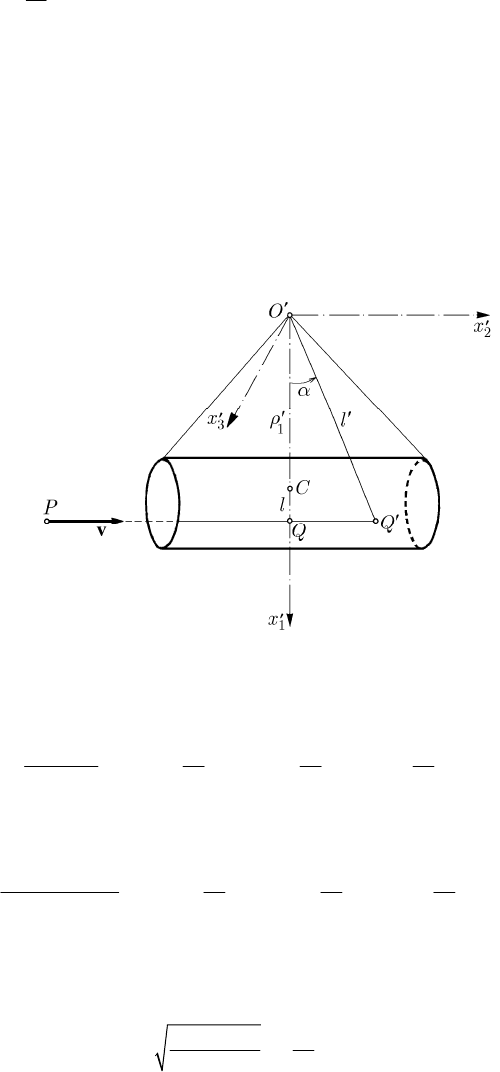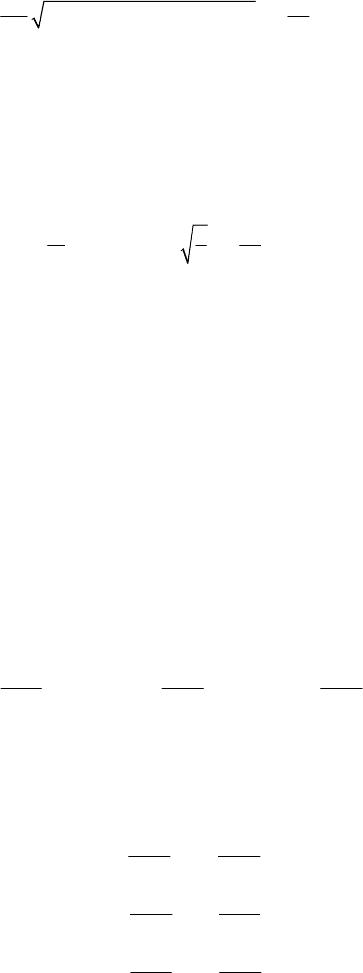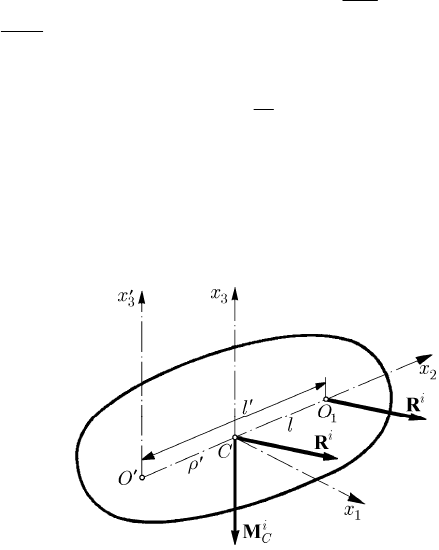Teodorescu P.P. Mechanical Systems, Classical Models Volume II: Mechanics of Discrete and Continuous Systems
Подождите немного. Документ загружается.


the calculation, we assume that the percussion P is applied at the point Q on the
2
Ox
-axis; it results
12
0
OO
MM==
too. From (17.2.32') we find the conditions
31 23
0II==,
1
0S = . Hence, the percussion P must be normal to the
23
Ox x -plane,
which contains the mass centre
C. As well, the axis of rotation must be a principal axis
of inertia at the point
O at which the plane which contains the percussion and is normal
to the axis is pierced by it.
We notice that
0
2
()
P
M
X
S
Δ=− ,
(17.2.33)
corresponding a loss or an increase of angular velocity, as
1
P and
2
S have the same
sign or are of opposite signs. Because
3O
MPE=− (in the hypothesis
1
0P > ), where
OQE = , Q being on the half-straight line
2
Ox (Fig. 17.20), the relations (17.2.32),
(17.2.33) lead to (
3
i
is the gyration radius corresponding to the axis of rotation)
2
33 3
22
Ii
M
E
SS
==,
(17.2.34)
the position of the point
Q, called centre of percussion, being thus specified. Using the
Huygens-Steiner theorem, the formula (3.1.113') allows to write
22 2
32
C
iiS=+, where
C
i is the gyration radius corresponding to an axis which passes through the centre of
mass
C and is parallel to the rotation axis; in this case,
22
lES S=+>,
2
2
C
i
l
S
= ,
(17.2.34')
the centre of percussion being farther from the axis of rotation than the centre of mass.
In fact,
E is the length of the mathematical pendulum synchronous with the physical
pendulum, formed by the rigid solid which is in rotation about the fixed axis
3
Ox
′
. All
the results obtained in Sect. 14.2.1.2 for the physical pendulum can be adapted to the
problem considered above. For instance, to a fixed axis
3
Qx (parallel to the
3
Ox -axis),
which is the principal axis of inertia for the rigid solid
S, corresponds the percussion
centre
O. We can thus state
Theorem 17.2.5 If the fixed axis % of a rigid solid S, which is in rotation, is a
principal axis of inertia for a point
O of it, then any percussion normal to the meridian
plane
P of the mass centre C (plane determined by the axis % and the centre C) at a
point of it, situated on a normal at
O to the axis %, at the distance E of it and on the
same part with the centre
C, does not give constraint percussions on the axis %.
MECHANICAL SYSTEMS, CLASSICAL MODELS
514

Hence, to any straight line %, principal axis of inertia at a point O of a rigid solid,
corresponds a centre of percussion
Q, so that on the axis %, as axis of rotation, do not
arise any constraint percussion. In particular, in case of a plate, to any straight line in
the plane of the plate corresponds a centre of percussion.
One can put also the inverse problem: The centre of percussion
Q being given, it is
asked to determine the position of the axis
% (of rotation) which is not acted on by the
phenomenon of collision. For instance, a blacksmith which strikes the anvil with the
hammer (at the point
Q) knows, instinctively, how to take the hammer so that not to
feel at the palm (at the point
Q) a too great shock (the point O is the point at which the
axis
% pierces the plane in which the hammer is rotating).
17.2.2.2 The Ballistic Pendulum
The ballistic pendulum is a device intended to measure the velocity of the projectiles,
formed by a metallic cylinder (e.g., of pig iron) filled up with a soft and viscous
material (e.g., earth); it is fixed at a point
O
′
and oscillates about a horizontal axis
3
Ox
′′
, its position being specified by an angle R made with the descendent vertical
1
Ox
′′
. The
12
Ox x
′′′
-plane is a plane of symmetry of the mechanical system S, passing
through the mass centre
C, situated at the distance
1
S
′
from the pole O
′
. At the initial
moment, the mechanical system
S is at rest with respect to the frame of reference
′
R
.
A projectile of mass
m, launched horizontally, at the distance
1
lES
′
=+
from the
fixed point
O
′
, in the plane of symmetry, with the velocity v, strikes the pendulum and
remains fixed at the point
Q
′
(specified by the angle B made by
OQ
′′
with the
1
Ox
′′
-axis and by OQ l
′′ ′
= ), on the horizontal of the point Q of the
1
Ox
′′
-axis (Fig.
17.21). The problem is put to determine the velocity
v if the angle
0
max
RR= ,
corresponding to the oscillations of the physical pendulum, is known.
The percussions between the projectile and the pendulum are internal and the
moment at
O
′
of the percussions of the
3
Ox
′′
-axis vanishes, so that we can apply a
conservation theorem of moment of momentum of the mechanical system
S formed by
the pendulum and the projectile. The moment of momentum before the interval of
collision is
mvE, after collision being equal to
()
2
0
Iml X
′
+
, where I is the moment of
inertia with respect to the
3
Ox
′′
-axis, while
0
X is the angular velocity of the
mechanical system
S ; equating these angular momenta, we get
0
2
mv
Iml
E
X
=
′
+
.
(17.2.35)
To the mechanical system
S one can apply the theorem of moment of momentum
with respect to the
3
Ox
′′
-axis in the form
17 Dynamics of Systems of Rigid Solids
515

()
[]
2
1
d
sin sin( )
d
Iml Mg mgl
t
XSR RB
′′′
+=− − +
,
M being the mass of the pendulum; multiplying by XR=
and integrating, there results
the relation
()()
[
]
{}
222
01
2 (1 cos ) cos cos( ) 0Iml gM mlXX S R B RB
′′′
+−+ −+−+=
,
(17.2.36)
corresponding to the theorem of kinetic energy, where, at the initial moment of this
motion (which coincides to the end of the interval of percussion), we imposed the
conditions
0R =
and
0
XX= .
Fig. 17.21 The ballistic pendulum
Making
0
RR= and
0X =
, we obtain
000
2
01
2
4
sin sin sin
222
g
Mml
Iml
RRR
XS B
ª§·º
′′
=++
¨¸
«»
′
+
¬©¹¼
,
(17.2.37)
wherefrom
()
2
000
2
1
22
4
sin sin sin
222
gI ml
vMml
m
RRR
SB
E
′
+
ª§·º
′′
=++
¨¸
«»
¬©¹¼
.
(17.2.38)
We notice that
cosl BE
′
=
.
If the projectile stops at the point
Q on the
1
Ox
′′
-axis, then we have 0B = , so that
0
1
0
2
2sin
2
Mm
Im
SE
R
X
E
′
+
=
+
,
(17.2.37')
MECHANICAL SYSTEMS, CLASSICAL MODELS
516

the velocity of the projectile being
()
0
2
1
2
() sin
2
vgMmIm
m
R
SE E
E
′
=++
.
(17.2.38')
The angle
0
R is measured experimentally on an indicator dial.
We observe that, in the given conditions, the
3
Ox
′′
-axis is a principal axis of inertia.
The pendulum is not acted upon by percussions on its axis of suspension (to have an as
small as possible wear of the device in running) if the projectile remains fixed at the
centre of percussion, hence at the point
Q, so that
2
1
/iIMSE
′
==
. We find thus
()
0
1
2
sin
2
g
vMm
m
R
SE
E
′
=+
.
(17.2.39)
17.2.2.3 Motion of a Rigid Solid with a Fixed Point Subjected to the Action
of a Percussive Force
Let be a rigid solid with a fixed point
OO
′
≡ , subjected to the action of a percussive
force, which leads to the percussion
P applied at the point Q; at the fixed point appears
a constraint percussion
R
P . We denote by
′
ω
and
′′
ω
the rotation angular velocities
before and after the interval of collision, respectively. The theorem of moment of
momentum with respect to the frame of reference
R reads
0
()
OO
Δ=I ω M ,
0
()
′′ ′
Δ=−
ω ω ω
,
(17.2.40)
the moment of the percussion
R
P vanishing, while
O
M is the moment of the percussion
P (eventually, the resultant moment of a certain number of given external percussions).
Projecting on the principal axes of inertia corresponding to the point
O, it results
()
1
1
0
1
O
M
I
XΔ= ,
()
2
2
0
2
O
M
I
XΔ= ,
3
30
3
()
O
M
I
XΔ= ,
(17.2.40')
obtaining thus the jumps of the angular velocity. The equation of motion of the mass
centre (17.2.4) allows to express the components of the constraint percussion in the
form
23
132
1
23
OO
R
MM
PPM
II
SS
§·
=− + −
¨¸
©¹
,
31
213
2
31
OO
R
MM
PPM
II
SS
§·
=− + −
¨¸
©¹
,
12
321
3
12
OO
R
MM
PPM
II
SS
§·
=− + −
¨¸
©¹
.
(17.2.41)
17 Dynamics of Systems of Rigid Solids
517

Introducing the ellipsoid of inertia
E, given by the equation (15.1.63), we can
consider the plane which passes through the fixed point
O and the moment
O
M , of
equation
123
123
0
OO O
Mx Mx Mx++=,
which can be written in the form
() ()
1 112 223303
00
() 0IxIxIxXXXΔ+Δ+Δ=
(17.2.42)
too. The diameter conjugate to this plane, with respect to the ellipsoid
E, will be of
equations
()()()
123
123
000
xxx
XXX
==
ΔΔΔ
,
(17.2.42')
representing just the support of the vector
0
()Δωω .
Hence, if we draw a plane tangent to the ellipsoid of inertia
E, normal to the
direction of the resultant moment
O
M of the given percussions (taken with respect to
the fixed point
O), the jump of the angular velocity vector
0
()Δωω will be situated along
the position vector of the tangent point (conjugate diameter of the considered plane). If,
before the interval of collision, the rigid solid
S is at rest (
′
=
0ω ), then, after the
action of the percussive forces, this solid begins to rotate about the support of the
position vector of that point of the ellipsoid
E at which the tangent plane is normal to
the resultant moment of the percussions, with respect to the fixed point
O. The
connection between the considered mechanical phenomenon and the geometric aspect
given by Poinsot to the Eulerian case of motion of a rigid solid with a fixed point is thus
put in evidence.
17.2.2.4 Motion of a Free Rigid Solid Subjected to the Action of a Percussive Force
Let us consider a free rigid solid
S, subjected to the action of a percussive force, which
leads to the percussion
P applied at the point Q. We denote by
C
′
v ,
C
′′
v and
′
ω
,
′′
ω
the velocities of the mass centre
C and the rotation angular velocities of the rigid solid
about this point, with respect to an inertial frame of reference
′
R
, before and after the
interval of percussion, respectively. The equations (17.2.1), (17.2.3) read
()
0
C
M Δ=v R
,
(17.2.43)
0
()
CC
Δ=I ω M ;
(17.2.43')
we can thus calculate easily the jumps
()
0
CCC
′′ ′
Δ=−
vvv
and
0
()
′′ ′
Δ=−
ω ω ω
. We
get
()
0
1
C
M
Δ=
v R ,
(17.2.44)
MECHANICAL SYSTEMS, CLASSICAL MODELS
518

as well as (we use the central principal axes of inertia of the rigid solid
S )
1
10
1
()
C
M
I
XΔ=
,
2
20
2
()
C
M
I
XΔ=
,
3
30
3
()
C
M
I
XΔ=
.
(17.2.44')
Obviously, these results can be applied in case of an arbitrary number of external
percussions too.
17.2.2.5 Motion of a Rigid Solid Subjected Suddenly to a Fixation
One can study an inverse problem too: a rigid solid
S has an arbitrary motion; if, at a
given moment, one of its points is suddenly fixed, then the velocities of all points will
have jumps, intervening also the effect of unknown constraint forces. In this case too,
one must determine the velocities after fixing.
For instance, let us consider a rigid solid with a fixed point
O
′
and let us assume
that, at a given moment
0
t , a second point
1
O is fixed, so that the rigid solid S moves
now as a solid with a fixed axis. If
1
versOO
′
=
J
JJJJG
u , then we can write
()
0
0
O
′
Δ⋅=Ku,
()
0
OOO
′′′
′′ ′
Δ=−
KKK (putting in evidence the moment of
momentum after and before the collision, respectively), because the moment of the
constraint percussion which arises at
1
O vanishes in projection on the fixed axis
1
OO
′
.
After the fixation of the point
1
O
, we will have
O
I X
′
′′ ′′
⋅=
Ku , where I is the moment
of inertia with respect to the new axis of rotation, while
X
′′
is the corresponding
angular velocity. We can write
O
O
′
′′
=
KIω , where
′
ω is the angular velocity before
fixation, with respect to an inertial frame of reference
′
R
with the pole at OO
′
≡ .
Thus, takes place the relation
()
O
I X
′′′
⋅=
Iuω ,
(17.2.45)
which determines the angular velocity
′′
ω
(the initial velocity for the motion after
fixation); in a developed form, after the principal axes of inertia at
O, we have
111 222 333
Iu Iu I u IXXXX
′′′′′
++=
.
(17.2.45')
The motion is studied further using the results obtained in case of the rigid solid with a
fixed axis.
17.3 Applications in Dynamics of Engines
After some general results with a theoretical character concerning the dynamics of
engines, we deal with some applications concerning their running; we mention,
especially, the equilibration of the movable masses and the regulation of the working of
engines.
17 Dynamics of Systems of Rigid Solids
519

17.3.1 General Results
We call engine (machine) a set of mechanisms (a mechanical system
S, formed by n
rigid solids, eventually deformable,
j
S
, 1,2,...,jn= ), which perform prescribed
motions, with the goal to realize a useful work or to transform a mechanical energy. A
machine is formed, in general, by three parts: the driving mechanism, the transmission
gear and the mechanism of execution.
In the following, we present firstly some elements of kineto-statics, putting in
evidence the forces of inertia which act upon the engines. As well, we introduce some
mechanical quantities (reduced mechanical quantities), which can characterize the
motion of a machine in its totality (mass, moment of inertia, force, power).
17.3.1.1 Forces of Inertia which Act Upon the Machines. Elements
of Kineto-Statics
Upon a machine act: (i) given forces (which are external and known), as driving forces,
forces of technological resistance, forces of weight, forces of inertia, resistance of the
medium etc. and (ii) unknown forces, e.g., constraint forces in kinematic couples, forces
of friction, forces of balancing etc. They can depend on position, velocity and time or
only on some of these factors.
At the small devices, with reduced velocities, the forces of inertia can be – in general–
neglected, unlike the big devices (with great velocities), to which they can have
values of the same order of magnitude as that of the external forces. Let be
{}
{
}
,
OO
′′
τ=FRM and
{
}
{
}
iii
,
OO
′′
τ=FRM the torsors of the given and inertia
forces, respectively, with respect to a fixed pole
O
′
, for an element of the device (of
the mechanical system
S ). Corresponding to d’Alembert’s theorem 11.1.26, we can
write
{
}
{}
i
OO
′′
τ+τ=FF0,
i
+=RR0,
i
OO
′′
+=MM0.
(17.3.1)
Taking into account the universal theorems of mechanics, it results
i
d
dt
′
=−
H
R
,
i
d
d
O
O
t
′
′
′
=−
K
M
,
(17.3.2)
the differentiation taking place with respect to the inertial frame of reference
′
R
.
Choosing a non-inertial frame
R having the pole at the mass centre C, the torsor of the
forces of inertia at this point is given by (corresponding to the equations (14.1.47),
(14.1.48))
i
d
d
C
M
t
′
=−
v
R
,
(17.3.3)
i
()
CC C
=− − ×
MI Iω ω ω ,
(17.3.4)
MECHANICAL SYSTEMS, CLASSICAL MODELS
520

where M is the mass of the considered element,
C
′
v is the velocity of the centre of
mass,
ω is the rotation angular velocity vector, while
C
I is the central tensor of inertia.
Denoting by
′
ρ
the position vector of the mass centre, we can write
2
i
2
d
d
j
j
RM
t
S
′
=−
,
1, 2, 3j =
.
(17.3.3')
Analogously, we can write
()
[]
i
11 3 2 23
1
C
MIIIXXX=− + −
,
()
[]
i
22 1 3 31
2
C
MIIIXXX=− + −
,
()
[]
i
33 2 1 12
3
C
MIIIXXX=− + −
,
(17.3.4')
where we used the central principal axes of inertia,
123
III≥≥ being the
corresponding principal moments of inertia.
In case of a motion of translation (
= 0ω ), it results
i
d
d
C
M
t
′
=−
v
R
,
i
C
=M0,
(17.3.5)
the system of inertia forces of the element being thus reduced to a unique force of
inertia applied at the centre of mass and equal to the product, with a changed sign, of
the mass of the element by the acceleration of its centre of mass. We notice thus that, by
the starting of the motor, when the element has an accelerated motion, the force of
inertia is a resistant force; instead, at the stopping of the motor, the force of inertia
becomes a driving force. In particular, if
d/d
CC
t
′′
=av , then the element has a
rectilinear and uniform motion and is no more acted upon by a force of inertia.
In the hypothesis of a motion of rotation about a central principal axis of inertia (let
be
12
0XX==,
3
XX= ), we get
i
=R0,
i
33 3
C
IIX=− =−
Miω .
(17.3.6)
Hence, in case of the rotation of an element of the engine about one of these axes, the
system of forces of inertia is reduced to a couple, the moment of which is situated along
the axis of rotation, having its sense opposite to that of the angular velocity vector. As
above, there appear the notion of resistant couple and the notion of driving couple (due
to which the great and heavy runners (
3
I is greater) are rotating for a long time after
the ceasing of the action of the couple which produced the motion). If, in particular,
constX = , then the element has a motion of uniform rotation, non-being acted by any
force of inertia.
Let be now the case of rotation of the considered element about a principal axis of
inertia (the
3
Ox
′′
-axis), parallel to a central one (the
3
Cx -axis); hence,
12
0XX==,
3
XX= and we have
17 Dynamics of Systems of Rigid Solids
521

i
C
M
′
=−Ra,
i
3
C
I=−
M ω .
(17.3.7)
Observing that
3
C
Ox
′′′
⊥a (the centre C has a motion of rotation in a plane normal to
3
Ox
′′
), hence
C
′
⊥
a ω , it results that the scalar of the torsor of the forces of inertia
vanishes (
ii
0
C
⋅=RM
, so that this system of forces is reduced to a resultant applied
at the point
1
O , on the straight line OC
′
(obviously, we choose the point
1
O
conventionally, the force
i
R , applied at
1
O , sliding along its support) (Fig. 17.22). We
choose the
2
Cx -axis along OC
′
and the
1
Cx -axis so that the frames
′
R
and R be
right-handed ones. Projecting on the axes of the frame
R, we obtain (we take into
account the intrinsic components of the acceleration
C
′
a , that is
1C
a SX
′′
=−
,
2
2
C
a SX
′′
=−
)
i
1
RMSX
′
=
,
i2
2
RMSX
′
=−
,
i
3
0R = ,
ii
12
0
CC
MM==,
i
3
3
C
MIX=−
.
(17.3.7')
The position of the point
1
O will be specified by
ii
113
3
//
C
lCO M R IMS
′
==− =
,
so that (
1
lOO
′′
= )
llS
′′
=+
,
2
C
i
l
S
=
′
,
(17.3.8)
where
C
i is the central radius of gyration with respect to the
3
Cx -axis. We notice that
the point
O
′
is a centre of suspension, while the point
1
O is a centre of oscillation of
the element, considered as a physical pendulum,
l
′
being the length of the
mathematical pendulum synchronous with this one.
Fig. 17.22 Rotation of an element of the engine about a principal axis of inertia
In case of a plane-parallel motion we have
12
0XX==
,
3
XX= (we choose the
12
Cx x
-plane as fixed plane), hence the torsor of the forces of inertia will be of the form
(17.3.7) too. The scalar of the torsor will be also equal to zero, so that the system of the
MECHANICAL SYSTEMS, CLASSICAL MODELS
522

forces of inertia is reduced to a resultant along the central axis, contained in the fixed
plane of equation (see the equation (2.2.31''))
iii
21 12
3
0
C
MxRxR+−=;
(17.3.9)
we associate the relations
i
1
1
C
RMa
′
=−
,
i
2
2
C
RMa
′
=−
,
i
3
3
C
MIX=−
.
(17.3.9')
The distribution of the accelerations is, in general, unknown; it can be obtained starting
from the accelerations of two points of the element and using the polygon of
accelerations and the method of the pole of accelerations (see Chap. 5, Sect.. 2.3.4 too).
The problem becomes complicated in case of elements of arbitrary shape, having a
complex motion; in this case, one can use the method of concentration of masses,
replacing the mass
M of the considered element by a system of masses
i
M
,
concentrated at the concentration points
i
P ,
1,2,...,in=
, chosen so that the action of
the new system of masses upon the other elements of the system be equivalent with the
action of the mass of this element. In this case, the sum of the torsors of the forces of
inertia corresponding to the concentrated masses, with respect to the mass centre, must
be equal to the torsor of the forces of inertia of the studied element, with respect to the
same centre. It is necessary that: (i) the sum of the concentrated masses be equal to the
mass of the element; (ii) the mass centre of the system of concentrated masses does
coincide with the mass centre of the element, their accelerations being equal. This
corresponds to a static repartition of the mass of the element. To obtain a dynamic
repartition of this mass, it is also necessary that: (iii) the sum of the kinetic energies of
the concentrated masses be equal to the kinetic energy of the element (hence, the sum of
the moments of inertia of the concentrated masses with respect to the mass centre be
equal to the moment of inertia of the element with respect to the same centre). It is
convenient that the points
i
P be on the axes of the articulations, being possible that one
of them does coincide with the centre of mass
C of the element. Practically, the mass
of an element is replaced by two or three concentrated masses.
Once the forces of inertia determined, the constraint forces of the kinematic couples
can be calculated by usual methods from the static study of the mechanical system
(analytical methods, grapho-analytical methods and graphic methods).
17.3.1.2 Kinetic Energy of an Engine
The kinetic energy of an engine can be calculated starting from the kinetic energy of
each element
i
S ; the quantities which intervene will be calculated with respect to a
fixed frame of reference
′
R
. In case of an element individualized by the index j, in
motion of translation, we have
2
1
2
j
jj
C
TMv
′′
= ,
(17.3.10)
17 Dynamics of Systems of Rigid Solids
523
